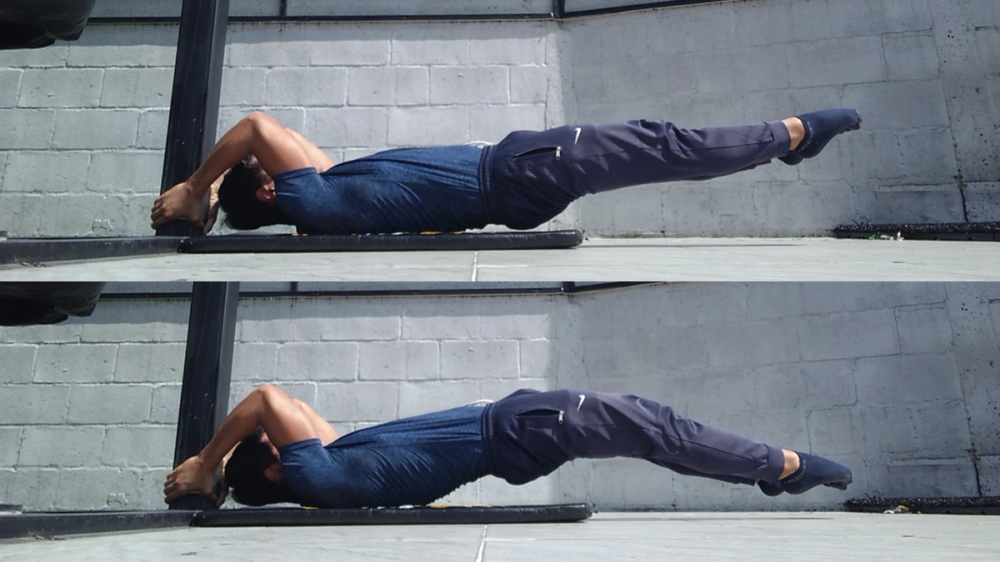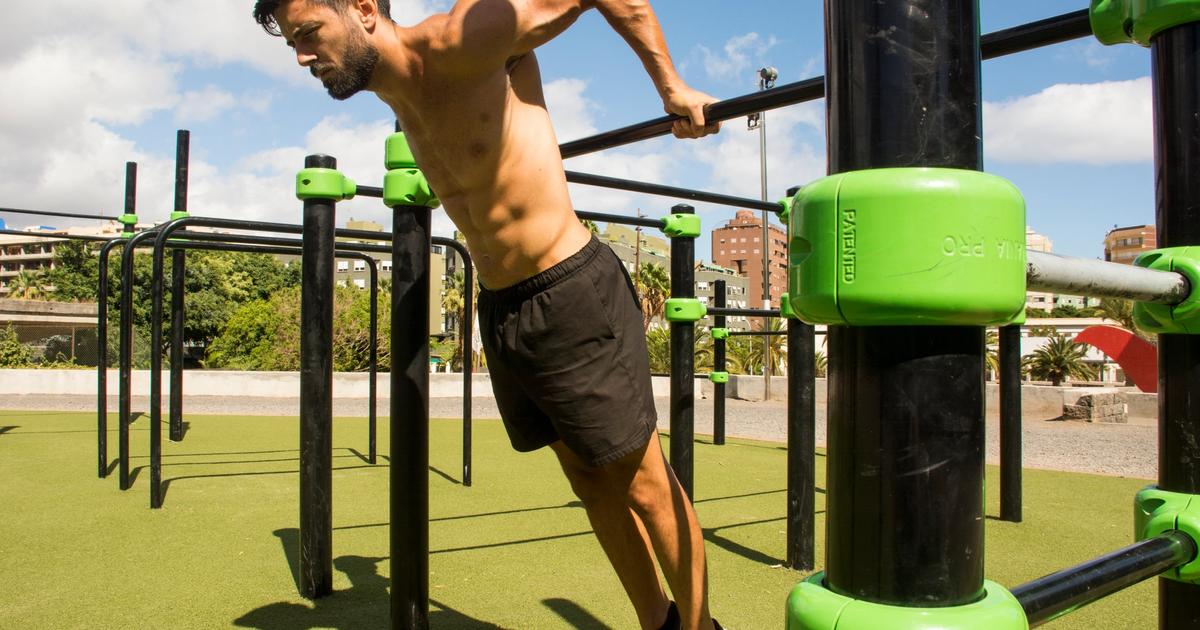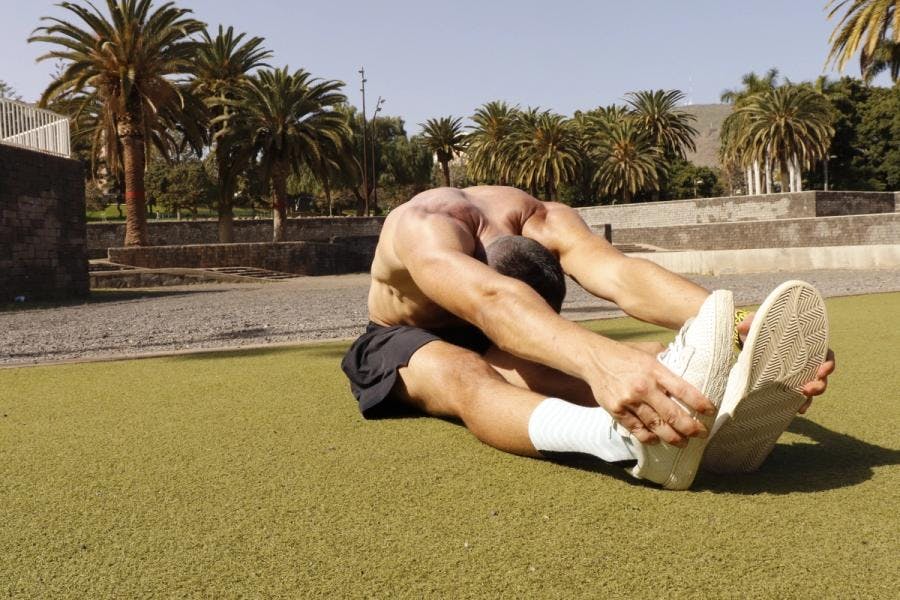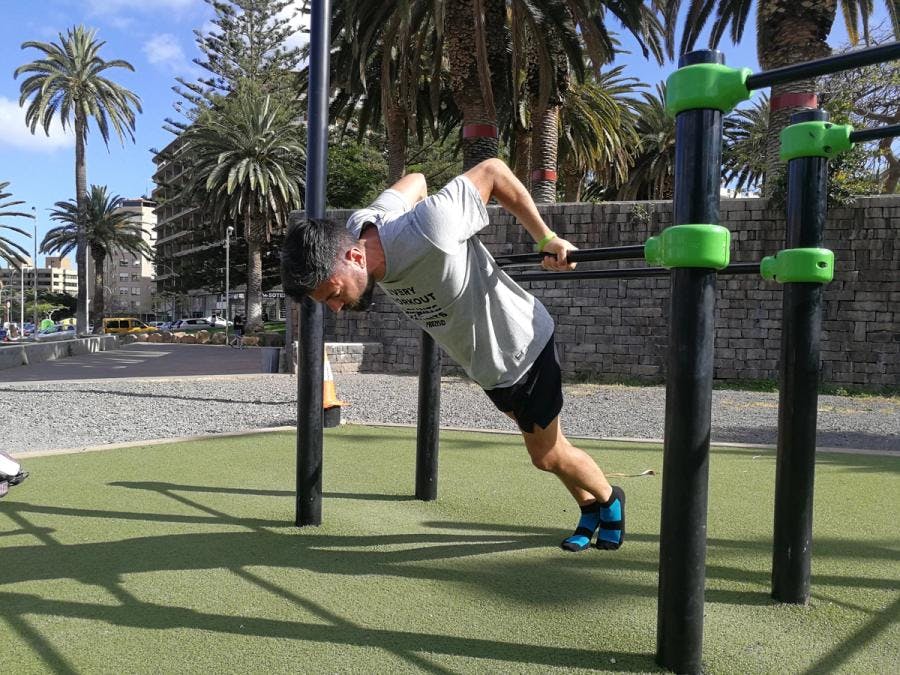
Calisthenic's Dragon Flag: complete guide with exercises
If you want to know everything about how to make dragon flags, here's a complete guide geared towards real progressions.

After almost a year specifically training to get the Hefesto, I finally did it. As you will see in this article, I have suffered a lot to achieve it and I have had ups and downs. That's why I have a lot of information and knowledge on this trick and I think that my experience can help you a lot.
This article will serve you as a complement to the Hefesto training program that you have available on the app.
Muscles involved and injury avoidance
The first thing to take into account about Hefesto is that it involves a lot of muscles from your torso. We are talking about biceps, forearms, shoulders and pecs mainly. It is also a very demanding movement, mainly for your wrists and elbows, so we will be careful and prepare correctly to avoid injuries when trying it.
What I did, and what I recommend you, is to spend 2 months doing the initiation and adaptation phase, which will help your wrists and elbows be prepared for the movements hefesto requires. Those exercises will also help you get a good base of strength for this trick. Let's see the exercises:
Preparation exercises
Flexibility
Another important part of this movement is flexibility. My experience is that people with a lot of flexibility on their shoulders and wrists can do this movement with much less difficulty, requiring less strength.
To make this point clear, we can say that to do Hefesto you need a minimum level in shoulder and wrist flexibility, and a minimum level in strength, but from there on, the more flexibility you have, the less strength you need.
So to be well prepared in this sense, lets work on the following exercises:
Now we have or preparation routine complete, as you can see we'll do the flexibility exercises in short sets as a warm up, and the at the end we will do long sets. You have this routine divided on each part in the first phase of the Hefesto training program.

Technique
To do hefesto you have to start getting your body under the bar and holding a supine grip. This step is crucial because your grip has to stay way over the bar, as much as you can. Use a lot of chalk and hold tight, your wrists will tend to go low under the bar, tray to avoid it.
When you have a lot of strength and flexibility in hefesto and you can do it without problem, you should be able to do it with your wrists under the bar, but at the beginning it is crucial that you let them up, so you can transition to a vertical position, and rest your weight against the bar to finish the movement.
The width of your hold should be a little bit wider than shoulder width.
Once we have a solid grip, then get your body to a tucked back lever position and start to pull. The pull is another crucial part because you need the required strength and you have to remember to pull to your armpits, instead of pulling to your lower back. If you pull to your lower back, you will touch the bar with it and you won't be able to continue flexing your arms to finish the movement.

Lastly we have the part in which you get your body vertical. To do this you have to arch your body a lot, like when doing a banana position, and keep flexing your arms as much as you can. This part has a certain rhythm to it and a little change of position that you might have trouble doing at the beginning, but with each try you will understand it a little more. Some people use a little kick to help this part, in my case I didn't do it but maybe it can help you.
If you are used to do hollow body position and avoid banana position, maybe it will be difficult to you to do it, but it is necessary to learn hefesto.
Also I want to point out that in this part is where you have to fight a lot. The first tries when you feel ready to hefesto, will feel eternal and you will struggle a lot, but you have to keep fighting, hold your grip over the bar, arch a lot and keep flexing your arms.
To end the movement you just swing a little bit so your butt doesn't get stuck on the bar and you do a korean dip to sit on the bar.
Exercises
Now that you know the preparation exercises to avoid injuries and get basic strength, plus the correct technique, lets see the key exercises that will help you strengthen every part of the movement and will help you to achieve it.
Routine
Here we have an example of a routine with those exercises, I recommend you to train it once or twice a week. With the Hefesto training program in the app, you will be including these exercises little by little on each phase so I recommend you to use that program and have this routine only as a reference.
3x1 Hefesto try 5x2 Eccentric Hefesto 4x4 Floor assisted Hefesto 4x8" Supine back lever 4x5 Korean dips with extension 4x12 Complete Hefesto pull, with stopper
2 minute rest periods. Once or twice a week. Short stretches before and long stretches after the routine.
If any of those exercises is too much for you, as can happen with the eccentric when you are not strong enough, my recommendation is to leave it to the side and to compensate add some of the preparation exercises that we saw at the beginning. Add it to the end of the routine because it will be easier that the others.
Its is a strength routine so we will do long rest periods. Our focus will be to execute the exercises correctly.
On the exercises that we just saw, except on the eccentric, our goal should be to do the pull phase as fast and vigorous as we can, but without sacrificing the technique. This will help you a lot with our goal.
My personal experience
To finish this tutorial I think it is interesting for you to know what I've been trough to ger hefesto and what I learned along the way.
When I decided to start training it, I knew it was a dangerous exercise that can cause injuries when not trained correctly, so I spent around 2 months doing the preparation exercises that we saw at the beginning, of course without trying to do hefesto, just preparing.
Once I felt my wrists, elbows and shoulders strong and prepared, I started to do the real exercises and to try hefesto. The first thing I noticed is that I lacked a lot of pull strength.
I worked on it and when I had more pull strength, what I noticed was that I couldn't set my body vertical, and it was because my grip moved from over the bar to below the bar.
To fix that I centered around getting them even further over the bar and getting more grip strength so they won't move. I found it helpful to try in rougher bars, that were less slippery.
Once I solved all those problems, I found that I wasn't arching my body correctly when going up to hefesto, and also I didn't flex my arms to the maximum point required. Also some times I forgot about the grip and I failed in that. Those factors made my first ever hefesto very clunky, in which I had to do a little tricky movement with one of my arms first and then finish the movement.
Once I got my first hefesto, I was really unlucky and got injured practicing freestyle movements, so I have to stop training hefesto for 3 months... and when I started again it was like starting from scratch.
I trained it hard for another 2 or 3 months and I did it again. During this time the key factors were: keep strengthening my pull, learn to pull to the armpit, not to the lower back, get more grip strength and arching my body correctly.
After doing it again, I kept trying almost every day, some days I did it, some days I was really close, and then I started to be able to do it every day. Some times even several times a day.
During my final period of training what I did was hefesto routine once a week, and a couple tries on every training day (5 or 6 days a week). I still haven't mastered this movement, but I can do it and I wanted to share what I've learned and my experience.
To finish, remember that you can apply what you have learned in this tutorial, using the Hefesto training program availible on the app.

Yerai Alonso
Cofundador de Calisteniapp, referente en calistenia y el street workout en Español. Con más de una década de experiencia, es creador de uno de los canales de YouTube más influyentes del sector. Autor del libro La calle es tu gimnasio, campeón de Canarias y jurado en competiciones nacionales e internacionales.
Join our newsletter
Learn everything you need to know about calisthenics

If you want to know everything about how to make dragon flags, here's a complete guide geared towards real progressions.

A detailed breakdown of all calisthenics statics. Learn about muscle activation, movement patterns, and precise execution for every isometric skill.

Calisteniapp v25.12.0 introduces program pause, performance improvements, and the 10’ Workout Challenge 2026. No shortcuts, just better tools
